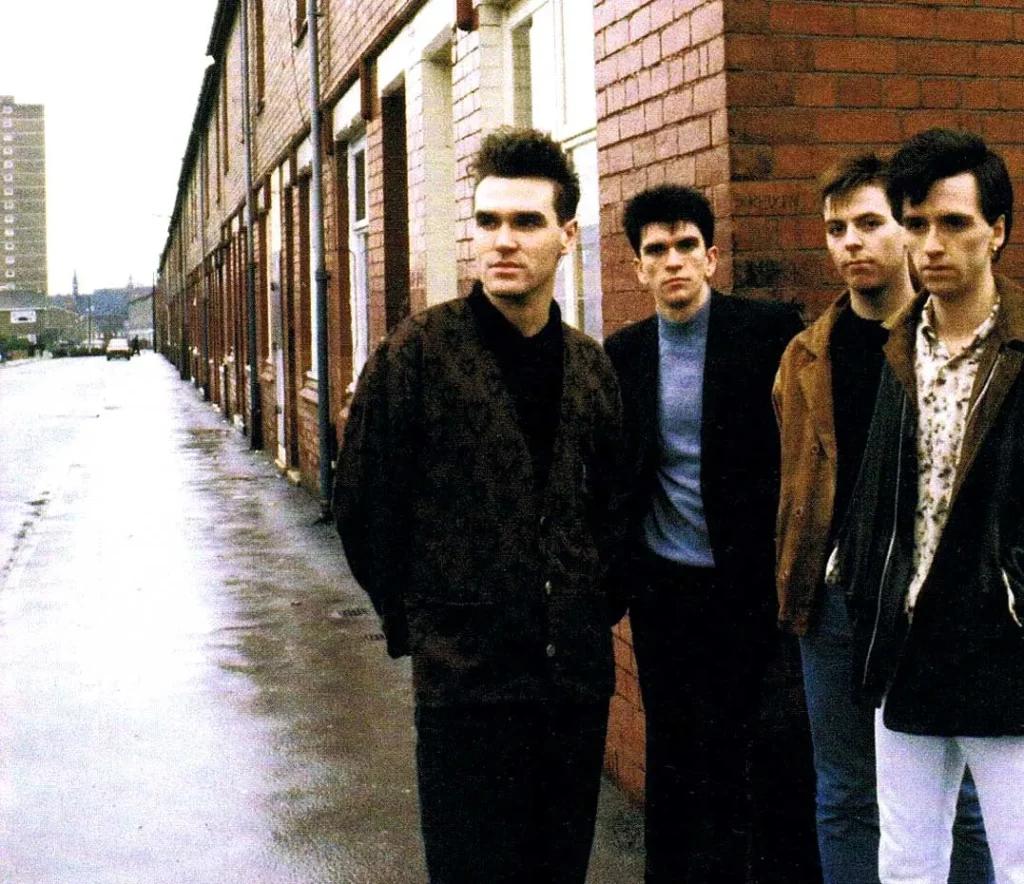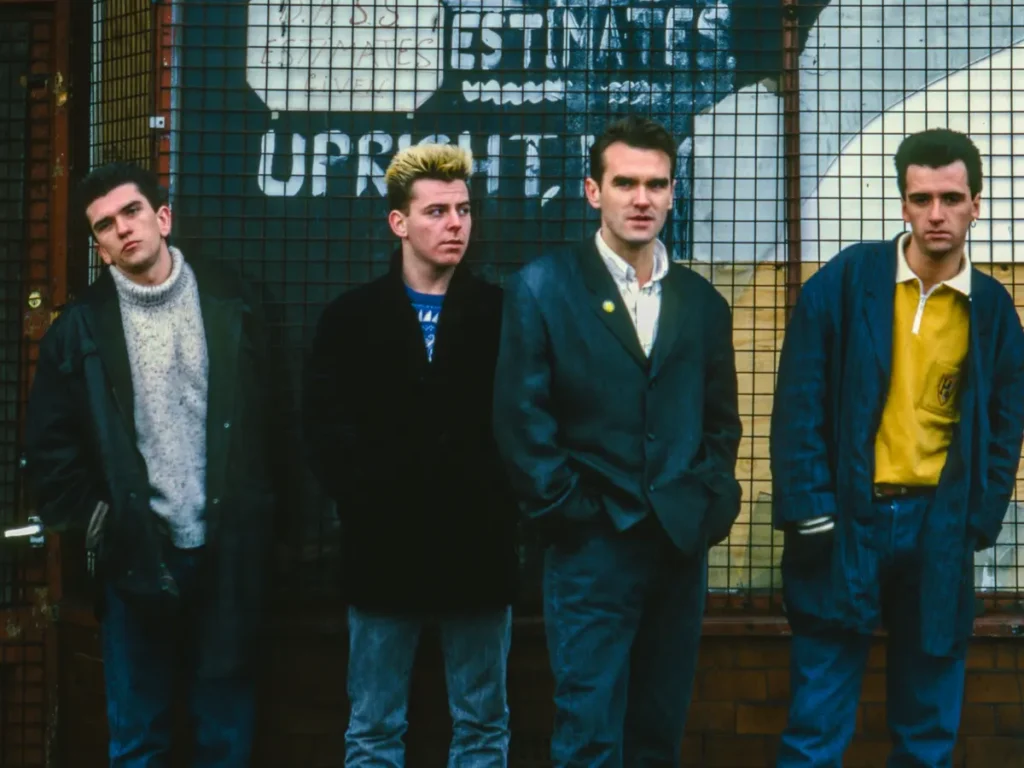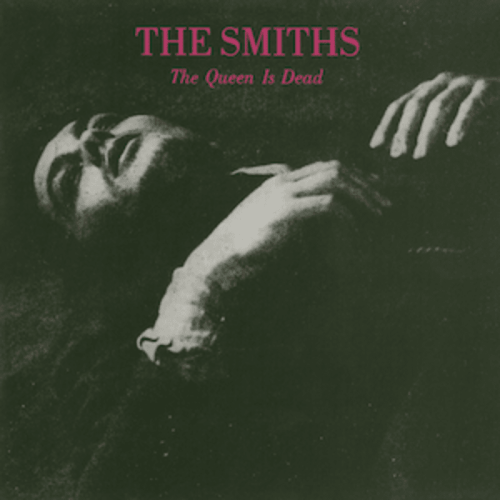Released in June 1986, “The Queen is Dead” is often celebrated as the crowning achievement of The Smiths‘ brief yet profoundly influential discography. Emerging at a time when pop airwaves were saturated with synth-driven arrangements, this album marked both a consolidation of the band’s jangly guitar aesthetic and a bold exploration into darker, more complex emotional territories. It isn’t merely a continuation of the motifs explored in their earlier works, such as the eponymous debut “The Smiths” (1984) and the follow-up “Meat is Murder” (1985); rather, it deepens and expands their exploration of societal and personal disillusionment.
Artistic Intentions
Artistically, “The Queen is Dead” showcases Morrissey’s sardonic wit and melancholic lyricism paired exquisitely with Johnny Marr’s innovative guitar work. The album was intended as a more cohesive and biting critique of contemporary British society, reflecting Morrissey’s observations and disenchantment with the cultural and political climate of Thatcher-era Britain. This intent is palpable throughout the album, from the ironic lament of the title track to the existential angst of “There Is a Light That Never Goes Out.”
Through interviews and the album’s lyrical direction, it becomes clear that The Smiths aimed to challenge the status quo, using their music as a vehicle for social commentary. The album’s production, led by Morrissey and Marr, further aimed to capture the rawness of their message, steering clear of the heavily produced sounds typical of the mid-80s. The result is an album that not only defined an era but also set a new standard for poetic expression in pop music, combining robust melodic hooks with deeply introspective and critical lyrics.
Sonic Exploration

The production of “The Queen is Dead” veers away from the polished sheen typical of the 1980s pop scene, instead embracing a more organic, sometimes gritty sound. This choice was deliberate, with Morrissey and Johnny Marr overseeing production to ensure the album retained a raw edge that mirrored its introspective and critical themes. The production quality, while not lo-fi by any means, eschews unnecessary gloss in favor of clarity and authenticity, allowing the emotional gravitas of the lyrics and the purity of the instrumentation to shine through. This approach enhances the album’s commentary on the bleakness and banality of contemporary life, making the music feel more immediate and urgent.
Musical Arrangements
The musical arrangements on “The Queen is Dead” are a testament to Johnny Marr’s genius as a guitarist and arranger. From the jangling discord of the title track to the hauntingly beautiful orchestration of “There Is a Light That Never Goes Out,” Marr’s ability to blend melody with noise helps create a complex sonic landscape. The album frequently uses layering to great effect; rhythmic guitar riffs are overlaid with shimmering chords and counter-melodies, creating a texture that is rich yet never overwhelming. The interplay of Morrissey’s distinctive vocal style with Marr’s dynamic guitar work creates an engaging auditory experience that remains memorable long after the record stops spinning.
Vocally, Morrissey experiments with a range of deliveries, from the monologue-style recitation in “Frankly, Mr. Shankly” to the melodious crooning in “The Boy with the Thorn in His Side.” This versatility not only showcases his vocal prowess but also serves the emotional and lyrical content of the album, enhancing the impact of each song.
Genre Elements
“The Queen is Dead” is firmly rooted in the post-punk tradition, yet it incorporates elements from a wider array of genres, including indie rock and jangle pop. This blending of styles is seamlessly executed, ensuring that the album feels cohesive and unified. The Smiths do not merely use these genres; they redefine them, contributing to the evolution of alternative rock. The album’s ability to transcend and meld musical boundaries not only defines its sound but also broadens its appeal, allowing it to resonate with a diverse audience. Each track, while distinct, contributes to a larger narrative of genre-blending that was revolutionary at the time and remains influential to this day.
Lyrical Analysis

“The Queen is Dead” is an album rich with thematic content, addressing issues from existential dread and romantic despair to sharp critiques of social and political structures. The title track sets the tone with a biting commentary on the British monarchy and the perceived cultural decay of England, wrapped in Morrissey’s trademark sardonic wit. Themes of alienation and disenchantment run through tracks like “I Know It’s Over” and “Never Had No One Ever,” where personal sorrow and societal isolation are palpably expressed.
Recurring motifs of death, love, and existential angst are woven seamlessly into the fabric of the album, creating a narrative thread that ties personal emotions to broader societal observations. Morrissey uses both direct narrative and more opaque, allegorical lyrics to craft stories that resonate on multiple levels, allowing listeners to find personal meaning in his reflections on broader issues.
Lyrical Depth
Morrissey’s lyrics on “The Queen is Dead” are both intellectually complex and emotionally rich. They oscillate between straightforward narratives and abstract, poetic expressions, often within the same song. For example, “There Is a Light That Never Goes Out” presents a seemingly simple story of longing and companionship, yet the imagery and metaphorical language elevate the song to a poetic meditation on life and death. The lyrical content is rife with literary references and clever wordplay, characteristic of Morrissey’s writing, which invites listeners to delve deeper into the text.
The complexity of the lyrics does not alienate but rather beckons the audience to engage in a more profound exploration of the text. This depth ensures that the album remains a subject of analysis and appreciation long after its release, as fans and critics alike uncover new layers of meaning with each listening.
Emotional Impact
The emotional impact of the lyrics on “The Queen is Dead” is significant and varied. Morrissey’s ability to articulate deep and often uncomfortable emotions with honesty and eloquence allows the album to resonate emotionally with its audience. Songs like “Bigmouth Strikes Again” deliver a cathartic release with their upbeat tempo and biting lyrics, while the melancholic “I Know It’s Over” can evoke profound sadness and sympathy.
Moreover, the lyrical content frequently stirs a contemplative response from the listener, inviting them to reflect on their own experiences and the world around them. The emotional range of the album—spanning from despair and irony to humor and hope—creates a rich tapestry that engages listeners on an emotional level, making “The Queen is Dead” not just a collection of songs but an evocative narrative journey.
Cohesion and Flow

“The Queen is Dead” is masterfully sequenced, creating a coherent flow that enhances both the narrative and emotional journey of the album. The opening track, which shares the album’s title, sets a defiant, energetically disillusioned tone, leading into the equally vigorous but more personal “Frankly, Mr. Shankly.” This progression from the political to the personal is a thread that weaves throughout the album, as subsequent tracks explore deeper emotional landscapes, reflective introspections, and biting social commentaries.
The flow from the wistful “Cemetry Gates” into the more tumultuous “Bigmouth Strikes Again” and then into the tender despair of “The Boy with the Thorn in His Side” showcases the album’s ability to navigate diverse emotional and sonic territories while maintaining a seamless narrative progression. The penultimate “There Is a Light That Never Goes Out” serves as a climactic emotional high point, encapsulating themes of longing and existential contemplation, before “Some Girls Are Bigger Than Others” closes the album on a note that mixes the absurd with the profound, mirroring life’s own blend of the trivial and the significant.
Thematic Consistency
Throughout the album, thematic consistency is meticulously maintained, with recurring motifs of death, existential crisis, and social critique interlacing the tracks. Musically, the album stays true to The Smiths’ signature style—jangly guitars, melodic basslines, and Morrissey’s distinctive vocal delivery—while also experimenting within these boundaries to keep the sound fresh but recognizably their own.
The Smiths manage to maintain a consistent mood of introspective melancholy punctuated by moments of sharp wit and buoyant rebellion. This balance ensures that the album feels cohesive; even as the emotional tone shifts from song to song, there is a clear undercurrent of shared themes and stylistic elements that binds the work together. The lyrical depth and the nuanced musical arrangements complement each other, reinforcing the album’s themes and enhancing its overall cohesion.
Standout Tracks and Moments

Key Tracks
“The Queen is Dead”: The title track sets an aggressive tone for the album, combining Morrissey’s incisive lyrics with Marr’s dynamic guitar work. The song’s driving beat and raw energy make it a powerful opener that encapsulates the band’s discontent with the British establishment.
“There Is a Light That Never Goes Out”: This track is often cited as one of The Smiths’ greatest songs, revered for its poignant lyrics and emotional depth. The melding of Morrissey’s melancholic narrative with the lush, orchestral arrangement creates a hauntingly beautiful atmosphere that captures the listener’s heart. Its refrain, “To die by your side, is such a heavenly way to die,” resonates as one of the most memorable in all of their catalog.
“I Know It’s Over”: Stark, somber, and deeply moving, this song showcases Morrissey at his lyrical best, delivering a raw, emotional soliloquy on loneliness and despair. The minimalistic arrangement allows the vocals to shine, making the emotional weight of the lyrics even more palpable.
Memorable Moments
The transition in “Bigmouth Strikes Again”: Johnny Marr’s guitar work shines exceptionally here, with a high-energy riff that contrasts sharply with the song’s lyrical themes of regret and remorse. This juxtaposition is a hallmark of The Smiths’ ability to blend upbeat sounds with darker themes.
The outro of “There Is a Light That Never Goes Out”: As the song builds to its climax, the orchestration swells into a lush, enveloping sound that perfectly complements the longing expressed in the lyrics. This crescendo is one of the most emotionally powerful moments in their discography, often leaving a lasting impact on the listener.
Lyric in “Cemetry Gates”: Morrissey’s wit is on full display with lines like, “A dreaded sunny day, so I meet you at the cemetery gates… Keats and Yeats are on your side, but Wilde is on mine.” This clever use of literary references not only underscores his erudition but also adds a playful layer to the song’s exploration of life, death, and morality.
Each of these tracks and moments stands out not just for their intrinsic qualities but also for how effectively they contribute to the album’s overarching themes and emotional landscape. They highlight The Smiths’ unique ability to combine profound lyrical content with compelling musical compositions, making “The Queen is Dead” a landmark in the alternative music genre.
Artistic Contribution and Innovation

“The Queen is Dead” occupies a pivotal place in the landscape of alternative rock and the broader music industry. Released at a time when synth-pop and stadium rock were dominating the charts, The Smiths’ album carved out a niche that celebrated introspection over ostentation, and emotional sincerity over commercial polish. It challenged the norms of the mid-1980s music scene, both in its sound and its substance, influencing a generation of musicians and listeners who were looking for something that countered the prevailing musical trends.
This album is widely regarded as a cornerstone of the indie music genre, helping to define what would become a significant movement in the late 80s and early 90s. Its blend of post-punk and jangle pop with introspective and literate lyrics set a new template for alternative music, emphasizing authenticity and emotional depth over the formulaic. In doing so, it pushed the boundaries of what popular music could convey and how it could sound, paving the way for numerous bands that followed in their footsteps.
Innovation
Lyrical Approach: Morrissey’s lyrics on the album are a high-water mark for literary quality in rock music. His ability to weave complex, emotive narratives filled with irony and wit into accessible pop songs was revolutionary at the time and has seldom been matched since. This literary prowess turned the standard pop lyric on its head, offering something both intellectually stimulating and emotionally resonant.
Musical Composition: Johnny Marr’s guitar work on the album is notable for its richness and complexity. He expanded the vocabulary of rock guitar, using a range of techniques from arpeggio sparks to shimmering jangles that provided a counterpoint to Morrissey’s vocal melodies. This interplay not only defined The Smiths’ sound but also influenced the guitar work of subsequent alternative bands.
Thematic Depth: The album’s exploration of themes such as existential angst, social alienation, and personal despair was, at the time, a bold divergence from the more typical rock themes of romance and partying. The Smiths’ willingness to tackle these heavier, more uncomfortable topics in a profound way set a new standard for how seriously pop music could take itself and how deeply it could resonate with its audience.
Production Choices: Opting for a sound that was crisp yet unpolished, Morrissey and Marr made a conscious decision to strip back the gloss that characterized much of the music from the mid-80s. This production style not only highlighted the emotional gravitas of the lyrics and the natural talent of the band but also emphasized the authenticity that became a hallmark of indie music.
Closing Thoughts

“The Queen is Dead” is a tour de force in the realm of alternative rock, showcasing The Smiths at the peak of their creative powers. Its strengths are manifold, beginning with the profound lyrical content that offers both wit and weight, allowing the album to speak on both personal and political levels. Musically, the album benefits immensely from Johnny Marr’s inventive guitar work and the band’s cohesive sound, which balance perfectly with Morrissey’s distinctive vocal style and emotional delivery. The production, which favors authenticity over polish, further serves to enhance the raw, emotive quality of the music.
If one were to critique the album, it might be argued that its unflinching introspection and morose themes could be overwhelming for some listeners. The dense, literary quality of the lyrics, while a hallmark of Morrissey’s genius, might also obscure their meaning for those not attuned to his particular style of expression. However, these elements are also what endear the album to its many admirers, making it a profound piece of musical artistry that demands and rewards deep engagement.
Final Thoughts and Impact
“The Queen is Dead” is not just an album; it is a statement, an artistic beacon that has illuminated the path for countless bands and songwriters who seek to infuse their music with both intellectual and emotional depth. For The Smiths, this album represents the pinnacle of their art, capturing all the elements that made them so influential within the music scene. It encapsulates a perfect storm of lyrical genius, musical innovation, and emotional resonance that few albums have managed to achieve.
Given its enduring impact on listeners and its pivotal role in shaping the landscape of indie and alternative rock, “The Queen is Dead” deserves a perfect rating. 10 out of 10 isn’t just a score; it’s an acknowledgment of the album’s flawless integration of content and form, its ability to challenge and charm its listeners, and its standing as a masterpiece in the annals of music history.
This album is not only a must-listen for fans of The Smiths but for anyone who appreciates the power of music to convey profound truths in beautiful and innovative ways. Its echoes can be heard in the music of many artists today, and its influence will undoubtedly continue to resonate in the years to come.
